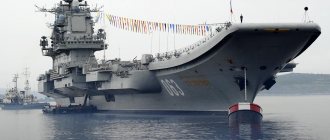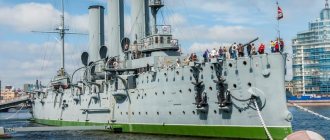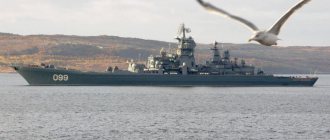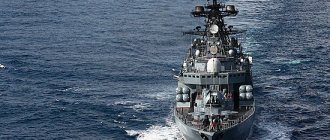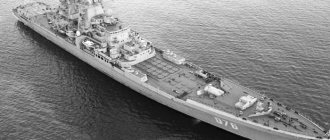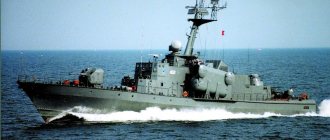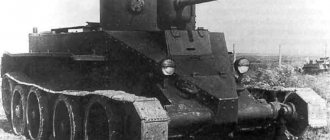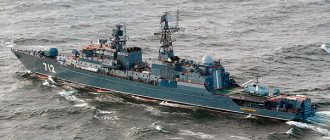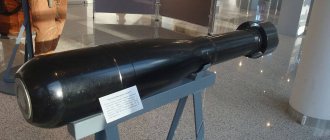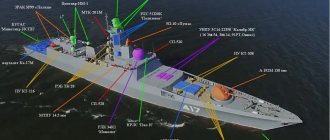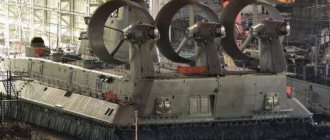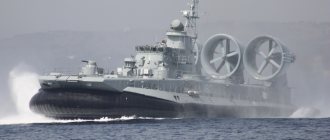Missile cruisers
With the advent and proliferation of ballistic missiles and missile launchers, ideas about methods of combat have once again undergone significant changes.
Expert opinion Isaac Yakovich Zelder Soviet astrophysicist, physical chemist, Doctor of Physical and Mathematical Sciences, Academician of the USSR Academy of Sciences, designer, engineer. Hero of Socialist Labor of the USSR.
Now it was possible to hit a target that was several hundred kilometers away with one click of a finger. And conventional artillery cruisers looked outdated and backward. At least in the eyes of Secretary General Khrushchev, who loved missiles and did not like ships.
Project 58
It was launched in 1956 with the goal of ensuring superiority in the seas and oceans, without having superiority in numbers. Therefore, the emphasis was on modern advances in technology, including nuclear and rocket technology. The first sketches appeared in 1957, and production was approved in 1958. In July 1962, before Khrushchev’s eyes, test launches of missiles were carried out, which impressed the ruler of the USSR. Now the dislike for ships was forgotten.
Missile cruiser "Varyag"
A total of 4 missile cruisers were produced - “Grozny”, “Admiral Fokin”, “Admiral Golovko” and “Varyag”. They were laid down in 60-61, launched in 61-63. In the 90s, everything, except for “Admiral Golovko”, was written off as scrap. He lasted until the end of 2002.
The basis of the armament was an anti-ship missile system (ASMS) with a missile almost 10 meters long and weighing 4.2-4.5 tons. Firing range - 100-300 km, flight altitude - from 300 meters to 7 km.
Project 1164
They were the next step in the development of missile cruisers. Construction began in 1972. Having passed through a sieve of competitive works, the final sketch was approved in August 1974. Initially they planned to produce 10 units, but during the work they agreed on only 3. The first ship was laid down in 1976 and entered service in 1983. Now all three are in service with the Russian Navy - this is “Moskva”, another “Varyag” and “Marshal Ustinov”. There were several subtypes of weapons - anti-ship, anti-submarine (designed to destroy submarines), two rocket launchers designed to destroy torpedoes fired at the ship, 10 anti-aircraft missile launchers, 6 anti-aircraft guns and two 130 mm caliber naval guns. As you can see, such cruisers were armed to the teeth. The main combat weapon is 16 Vulcan launchers. Such a rocket weighs 6 tons and has a maximum speed of 3000 km/h. The damage radius is 700 km. It is also worth noting a set of torpedoes aimed at destroying mainly enemy submarines. In total, there were 10 of them in basic stock, up to 7 meters long and weighing about 2 tons. Such a colossus could accelerate up to 100 km/h, and hit targets at a distance of up to 22 km.
Project 1144
And finally, for dessert - nuclear-powered jet cruisers. They were built between 1973 and 1996. Since the ships were built over a long period of time, the auxiliary weapons on them can vary greatly, depending on the year of launch and the development of technology at that time. The most advanced guns, which is logical, were installed on the most recent ship, the Peter the Great.
Heavy nuclear missile cruiser "Peter the Great"
Expert opinion Alexander Nikolaevich Rumyantsev Inventor, owner of many patents, candidate of technical sciences, professor at St. Petersburg Technical University.
The basis of the guns of each ship is the P-700 “Granit” anti-ship missiles. With a length of 10 meters, they reached a mass of 7 tons and could reach speeds of over 3000 km/h.
Carry a nuclear charge in a warhead. Also worth noting are the Osa-M and Kinzhal anti-aircraft missile systems. The anti-aircraft artillery was AK-130 with a caliber of 130 mm, there was an RPK-6M Vodopad anti-submarine missile-torpedo system, a Smerch-3 naval bomb launcher and Udav-1M anti-torpedo missiles.
A distinctive feature of the Project 1144 cruisers was the nuclear power plant, which acted as the heart and engine. It operates for 10-11 years without recharging. A total of 4 ships were produced - “Kirov”, “Admiral Lazarev”, “Admiral Nakhimov” and “Peter the Great”. Of all those listed, only the last one is currently serving in the Russian Navy. The rest have either been scrapped or are being modernized.
The name of Admiral Ushakov on board the ship
On October 20, 1696, the Boyar Duma met in Moscow to resolve an issue of great national importance: to be or not to be a fleet, the construction of which Tsar Peter I insisted on. The Duma decided: “There will be sea-going vessels.” From this date the official chronology of the regular navy of our country begins. The idea of its creation was not a whim of the impulsive and quick-to-deal young king. The course of economic and political development of the Russian state at the end of the 17th century urgently required the construction of a fleet. Peter I understood that without access to the sea, without maritime connections with the outside world, Russia could not become a great power and would be doomed to foreign policy isolation, economic and cultural backwardness, and to second roles among European states.
But do we remember this today?
The coastal defense battleship Admiral Ushakov was laid down on June 16, 1892 at the Baltic Shipyard in St. Petersburg. In August of the same year he was included in the list of ships of the Baltic Fleet. It was launched on October 27, 1893, and entered service in September 1897. The main dimensions of the ship impressed contemporaries - length 84 meters, width 15 meters, height 5 meters, displacement - 4648 tons. The battleship could reach speeds of up to 16 knots. The crew size is 406 people [1].
The coastal defense battleship Admiral Ushakov was part of the second Pacific squadron of the Baltic Fleet during the Russian-Japanese War. The battleship was commanded by Vladimir Nikolaevich Miklouho-Maclay. He knew the biography of Admiral Ushakov well and often told sailors about the “valiant old man.” Usually the conversation took place in the wardroom, where on the wall hung a portrait of Fyodor Ushakov, presented to the crew by one of the admiral’s descendants. Pointing to the portrait, V. N. Miklouho-Maclay expressed confidence that the ship, when meeting the enemy, would be worthy of its name. And so it happened.
Proceeding independently to Vladivostok after the Battle of Tsushima on May 15, 1905, the battleship died heroically in an unequal battle with two Japanese cruisers, which were many times superior to it in both displacement and firing range. Essentially, the Japanese cruisers shot at the Russian battleship in cold blood without making “contact” [2].
On September 2, 1905, the battleship was excluded from the lists of ships of the Baltic Fleet.
The cruiser "Admiral Ushakov" of project 68 bis was laid down on August 31, 1950 in the city of Leningrad, at plant No. 189, according to the design of chief designer A. S. Savichev. The ship was launched on September 25, 1951, and on December 8, 1953 it entered service.
A total of fourteen cruisers of this type were built: “Sverdlov”, “Zhdanov”, “Ordzhonikidze”, “Dzerzhinsky”, “Alexander Nevsky”, “Admiral Lazarev”, “Alexander Suvorov”, “Admiral Ushakov”, “Admiral Nakhimov”, “ Molotovsk" ("October Revolution"), "Admiral Senyavin", "Prince Pozharsky", "Mikhail Kutuzov", "Murmansk". Seven cruisers were not completed construction - "Kronstadt",
"Arkhangelsk", "Varyag", "Shcherbakov", "Admiral Kornilov" and
"Vladivostok".
The cruiser had an all-welded hull with 24 bulkheads. Its length was 210 m, width - 22 m, height - 7 m. Total displacement was 16,340 tons, crew 210 people.
The main power plants are six steam boilers and 2 turbines with a capacity of 12,000 hp. s., allowed to develop a maximum speed of 32 knots. Radar systems were installed on the cruiser - “Guys-2”, “Reef”, “Neptune”.
The ship had large reserves of provisions, fresh and boiler water, high-performance evaporation and desalination plants, refrigeration machines, air heating and cooling systems, as well as large life-support units. A characteristic feature of the ship was its high survivability, unsinkability, fire and explosion safety.
The cruiser "Admiral Ushakov" was transferred from the Baltic Fleet to the Northern Fleet. During the 34-year service life of the ship, not a single accident occurred on it. In 1988, the ship was excluded from the lists of Navy vessels [3].
The laying of the Red Banner missile cruiser "Kirov" (the honorary title was awarded on July 25, 1977) was carried out on March 27, 1974 at the Baltic Shipyard named after Sergo Ordzhonikidze. On December 7, 1977, the ship was launched, and on December 30, 1980, an act of acceptance of the ship into the USSR Navy was signed
In total, five ships of this class were built at the Baltic Shipyard - Admiral Ushakov (Kirov), Admiral Lazarev (Frunze), Admiral Nakhimov (Kalinin), Pyotr Velikiy and one control ship - "Ural".
A few words about the tactical and technical data of cruisers of this class. It is 252 meters long, 29 meters wide, and 60 meters high, from the water to the top point on the antenna. The ship is equipped with two nuclear reactors with a capacity of 160,000 hp. s., which allow you to reach speeds of up to 30 knots (approximately 60 km/h) and are capable of providing energy to an entire city. The cruiser is designed to solve operational-tactical tasks, to search and destroy enemy aircraft carriers and submarines, to launch missile attacks on coastal targets, and can accommodate three helicopters on board.
The main strike complex at Ushakov is Granit. These are 20 cruise missiles that can carry nuclear warheads capable of hitting targets at a distance of 700 km. The cruiser is also armed with the Metel anti-submarine complex. These missiles can carry torpedoes through the air at a distance of up to 80 km. The ship is equipped with the Osa missile system, which has a range of up to 20 km. For its own defense, the cruiser has anti-aircraft missiles with a range of hitting air targets at a distance of up to 80 km, anti-submarine rocket launchers with a range of hitting targets up to 60 km, and missiles for destroying torpedoes. Plus, there is naval artillery for various purposes, including 100-mm cannons and smaller ones [4].
Any, even the most modern technology, means nothing without a person. According to the deputy commander for educational work, the cruiser’s personnel are highly professional and friendly. Since 1995, about 300 conscripts from the Arkhangelsk region served on the ship, among them: Igor Starodubov from Kotlas, Alexey Grishin from Severodvinsk, Vasily Podosenov from the village of Vershinino, Plesetsk district, Anton Voronov from Naryan-Mar, Igor Bykov from Arkhangelsk. Today seven of our fellow countrymen serve on the cruiser.
In 1986, the cruiser Kirov, carrying out a combat mission in the Atlantic, removed the crew of a Russian submarine in an accident from the water. In 1989, the cruiser’s crew did everything to save the surviving submariners from the Komsomolets submarine that sank in the North Sea.
Some time later, in 1990, the cruiser itself had to survive an accident. During a military campaign in the Mediterranean Sea, a crack was discovered in a nuclear reactor. The cruiser then reached its native shores under its own power and stood next to the quay wall for a long time. In 1992, by decree of the President of the Russian Federation, the cruiser Kirov was renamed Admiral Ushakov.
Since 1999, the cruiser has been in Severodvinsk, anxiously awaiting a fateful decision. There was a time when they even wanted to cut the ship into metal, but Russia can’t build a second one like it now, so first the Federation Council adopted a resolution dated October 14, 1999 “On the need to preserve the cruiser Admiral Ushakov in the Navy’s operational composition.” On January 13, 1999, the State Duma of the Russian Federation adopted a similar resolution. But the decision of the Federal Assembly is one thing, and the opening of funding is completely different.
The combination of the power and intelligence put into this ship with its current situation is amazing and depressing. But a ship of this class is not only the pride of the Navy, but the prestige of Russia. "Weser". It had two decks, two diesel engines with a power of 3800 hp each. With. The length of the vessel was 155 m, width - 18 m, height -10 m. The total carrying capacity of the ship was 10,820 tons, net carrying capacity - 9,000 tons, loaded displacement - 16,620 tons, draft without cargo - 3.36 m. , loaded - 8.32 m.
Intensively developing, since the 20s. XX century in the Arkhangelsk region, the timber industry also required special transport for timber rafting. This is how the “water worker” appears.
The towing wheeled steamer "Admiral Ushakov" was built in 1948 at . The vessel was intended for towing non-self-propelled ships and rafts. The type of vessel is a towing steamer with side wheels and developed superstructures on the bows. The overall dimensions of the vessel were: 57 m long, 17 m wide, 9 m high. The displacement of the vessel with full reserves, operating on liquid fuel is 346 tons, on solid fuel - 363 tons. The average draft was 1 meter. The ship had 26 seats for the crew, and its endurance was 8 days.
This ship was assigned to the Northern River Shipping Company and sailed along the Northern Dvina. It was decommissioned in 1986 [6].
Fyodor Ushakov played a significant role in the history of our state and fleet. I consider it an honor that the ships named after him are associated with the history of our region.
Note:
1. Berezhnoy S.S. Linear and armored ships. Gunboats. Directory. M.: Voenizdat, 1997. pp. 107-108. 2. Prayer in the Russian fleet (16-2003) // https://rusvest.ru/index.php?s&13&16-2003 3. Artillery cruisers pr. 68, 68-bis of the Sverdlov type and their modifications // Marine collection . 2003 N 10. 4. Pavlov A. S. Military ships of the USSR and Russia. 1945 - 1955 Directory. Yakutsk, 1994. pp. 69-71. 5. Sea dry cargo transport vessels. Directory. L.: Transport, 1968. P. 13 - 14. 6. Archive of the Northern River Shipping Company.
https://www.pobeda.ru/content/view/4694/21/
Notes
- When using a backup power plant on regular fuel.
- The dismantling of the cruiser was planned for 2016, but then it never happened.
- Named in honor of the light cruiser of the Twice Red Banner Baltic Fleet, which took part in the Great Patriotic War. He, in turn, was named in honor of the Soviet statesman Sergei Mironovich Kirov.
- During the first mooring in Severomorsk, the Kirov, despite its size and displacement, performed it with its own vehicles, without the help of tugs - which showed both the good handling of the cruiser and the professional skill of the commander and crew.
- It is noteworthy that the Red Banner Naval flag of the missile "Kirov" was genuine - the same one under which the light cruiser "Kirov" sailed during the Great Patriotic War. At first it was supposed to send this flag to the museum, but on the initiative of the council of veterans of the honored cruiser, its battle flag was presented to the crew of the new nuclear-powered ship.
- Quoted from “Order 800” by B. P. Ponomarev
- A number of sources erroneously indicate that during this cruise the main gearbox of the GTZA failed on the cruiser, which in fact did not happen - see “Order 800” by Boris Ponomarev.
- There are discrepancies with the exact date of the cruiser's renaming - there are versions about May and October 1992. In fact, the letters of the first name still remained on the stern of the cruiser, only painted over with ball paint to match the color of the side. After 2004, when the name “Admiral Ushakov” was assigned to a destroyer in service, the crew of the nuclear-powered cruiser again cleaned off the paint on the letters “KIROV,” although the first name was not officially returned to the ship.
- In the Soviet Navy, the crews of warships were formed during the construction phase, so for the first commander, the date of taking office does not coincide with the formal year the cruiser began service. In the list, the ranks of commanders are given for the period of their tenure; for those who were awarded another title during this time, it is given in parentheses.
Near future
First, the first Voyager failed.
It was launched second, but due to a more optimal route, it took the lead and was the first to fly beyond the boundaries of the solar system, sparkling with a golden message on board. So he paid the price: the aliens simply burned him. NASA made a fuss, but nothing could be proven—the skeptics made everyone laugh. A month and a half later, the second Voyager failed. Only the New Horizons probe, which was launched to the border of the solar system after completing research in the Pluto system, managed to detect the “alien” ship.
The day when the news of all channels in the world began to broadcast photographs of the angular ship of the “alien” will never be forgotten.
Stock market panic, suicides and joint prayer services could not help - however, no one counted on it. It took six months to launch two joint reconnaissance missions. All this time, televisions, instead of weather forecasts, transmitted reports from observatories, which did not let the ship out of the sight of telescopes.
Scouts confirmed the previously announced information - the ship is heading towards the Earth, hiding behind a huge asteroid. It will not be possible to knock him off the ground with a direct blow. Something more serious is needed, and it is advisable to hurry: judging by the speed of the ship, a piece of iron with a mass of weapons on board will approach our planet in three years.
Of course, all of the above is just fantasy. Another thing is interesting: will the inhabitants of the Earth, working together, be able to assemble a military spaceship in orbit to cope with the aliens? And if so, how do they implement it?
Heavy cruisers of the USSR
During World War II, the Soviet command realized that it was lagging behind in naval armament, including in the number and quality of cruisers.
Armament of the cruiser Project 26
Despite the fact that the “Project 26” series performed quite well in battles, they were completely outclassed by heavy models. However, the first experimental sketches were created back in the mid-30s, when the smoke of a future conflict was just beginning to smoke over Europe. Unfortunately or fortunately, the fate of all the “heavyweights” turned out to be unhappy.
Project 69
Heavy cruisers of the Kronstadt class were presented to senior management in June 1938. The thickness of the armor was from 80 mm to 210.
Expert opinion Alexander Nikolaevich Rumyantsev Inventor, owner of many patents, candidate of technical sciences, professor at St. Petersburg Technical University.
It was armed with 9 305 mm caliber guns, 8 152 mm caliber guns, and 32 smaller caliber guns. It was also intended for combat in open ocean conditions, so the cruising range was more than 8,000 miles.
The cruisers Kronstad and Sevastopol were the first to be laid down in December 1939. In total they planned to build 15 cruisers. During the construction process, many technical problems arose; many guns could not be installed within the given time frame due to their unavailability. But they were not ready due to the fact that Soviet engineers did not have the necessary samples and the development of guns had to start almost from scratch. However, everything was in vain - when the war came, construction was mothballed, and all efforts were devoted to the defense of the country.
Image of the cruiser "Kronstadt"
“Kronstadt,” which was made in Leningrad, was dismantled for scrap metal; after the war, only half of what was built remained. “Sevastopol” faced the same fate, only now it was being used by the Germans. At the end of the war, all restoration work was considered inappropriate. The project went down the drain.
It is interesting that most of the technical elements that Soviet engineers did not have at hand planned to buy from Germany. In many cases, contracts were signed, money was paid, and deliveries were expected at the end of 1940, beginning of 1941. But for some reason they didn’t come. Yeah, for some reason.
Project 66
Despite the confusion in the numbering, now we will talk about the ideological heir of “69.” In 1947, it was decided to continue the construction of heavy cruisers, which in their parameters were more like medium ones. Since the Cold War had already begun, they had to be superior to their American opponent, ships like the Des Moines, in all respects. Development continued until 1954, when it was completely stopped.
American cruiser Des Moines
With an extremely high cost (900 million rubles for mass production), it was inferior to its competitor in almost everything, and was extremely vulnerable to air attacks and mine explosions. Therefore, senior management decided to call it a day and move on to more promising projects.
Project 82
If the Project 66 cruisers were heavy only in name, then the 82nd were full-fledged “heavyweights”. The order for development in 1946 was given personally by Stalin. The development was based on the captured German ship Lutzer, which was captured back in 1941. In principle, work on creating their own heavy ship began then, but due to the difficult conditions of the war there was no time and money for it. It had thick armor over 200 mm, and had 9 SM-33 cannons of 305 mm caliber as its main armament. The mass of one projectile was over 400 kg!, and the maximum flight range was approximately 50 km. It had special light-type shells with a firing radius of up to 120 km. Two ships were laid down - “Stalingrad” and “Moscow”. Both began construction in 1951. In 1953, after Stalin’s death, they were dismantled for scrap.
Heavy cruiser "Stalingrad"
This is the sad history of heavy cruisers in the USSR. None of them were ever put into service, and in the future the government of the Soviet Union did not see the point in building ships of this type, since it assigned the tasks of fighting similar enemy ships to other combat units.
Shipyard in orbit
Building such a ship on Earth is a pointless option. The largest super-heavy rockets - both of the past (Saturn 5 and Energia) and of the present (SLS, which is not yet flying, and Falcon Heavy) - can deliver no more than 100 -120 tons of cargo. For example, let’s imagine that the star cruiser of earthlings (contrary to tradition, let’s call it “Kirov”) weighs approximately the same as a sea cruiser (total displacement - 9436 tons), and the amount of work is approximately the same.
We will make the shipyard in orbit, approximately like the ISS currently - 380-400 kilometers above the sea surface. At this altitude, the influence of the earth's atmosphere is still there, but not as great. As a last resort, we will slightly raise the cruiser’s orbit using the engines of arriving cargo spaceships. This is what they are doing with the ISS now - they fire the engines of space trucks several times a year and raise the orbit. Actually, construction also needs to begin near the ISS (currently there are about six crew members working there, but this is not enough, really not enough).
To begin with, we will organize slipways (without their help, it will be very difficult to install parts of the structure sent from Earth). Their weight is approximately 1/20 of the weight of the cruiser, 470 tons (this is in space, you don’t need to hold the ship, it’s just a matter of convenience). If we count by weight and not by volume, earthlings will need to launch approximately 20 Proton launch vehicles or eight Falcon Heavy.
Anton Zheleznyak Technical and engineering expert
If this happens not just “the day after tomorrow,” but at least in a couple of decades, then the lunar base will greatly help the orbital plant with materials. Surely there is enough aluminum in the lunar soil. According to recent research, there is also a lot of water (which means hydrogen and an oxidizing agent can also be produced). And right at the orbital shipyard, using drawings from Earth, huge three-dimensional printers will create the required parts of the required shapes and sizes.
In total, if you count by weight, building a cruiser will require about 400 launches of heavy missiles. The smartest thing to do would be to split the load between the launching countries to save time. The main operators of heavy missiles at present are the USA, Russia, China, and Europe. In just a few years, India will join them. This turns out to be approximately 120-130 launches per country in three years (now we are talking exclusively about the delivery of materials and finished parts, and it is not always possible to load them to capacity).
Is it realistic to launch such a number of missiles? In 1985, the USSR made a hundred launches (three of them were unsuccessful) during the year from just two cosmodromes - Baikonur and Plesetsk (well, and one from Kapustin Yar). In three years, making one and a half hundred launches is more than realistic, subject to maximum vital necessity.
It will greatly help if the Big Falcon (150 tons in LEO) and SLS (131 tons in LEO in maximum configuration), the Chinese Long March 9 (133 tons in LEO), as well as the Russian super-heavy jet with approximately the same load.
Italian prototype for Soviet cruisers
At the end of the 1920s Not one of the USSR fleets could boast of a large number of modern warships; the situation with ships of large displacement was especially deplorable. Of the more or less modern projects, the RKKF only had three Svetlana-class cruisers, but these ships were laid down even before the revolution.
The first experiments in the design of even relatively small patrol ships of the Uragan type showed that the training of specialists, equipment, production facilities - all this the Soviet country had just yet to create, but this would take years and billions of invested rubles.
A modern, powerful fleet was needed now, therefore, the only reasonable remedy for the leadership of the RKKF at that difficult time was attempts to buy warships abroad. However, firstly, the situation in the world was such that more than one leading naval power did not want to part with its new ships voluntarily, and even at a reasonable price, and secondly, even then the USSR was considered in the West as a prototype of an “empire.” evil,” which was dangerous to arm at your own risk.
And yet, negotiations on the purchase of ships were ongoing.
Italian cruiser "Raimondo Montecuccoli" - prototype for "Kirov"
And from above we send you greetings
Where will space assemblers live? The ISS took several years to build, and even then it can accommodate a maximum of two dozen people. But even with a shift system, they need a place to sleep, eat and go to the toilet.
The easiest way to solve this problem is with inflatable modules. One of these already exists - the Bigelow Expandable Activity Module (BEAM) - and is currently being tested on the ISS. It is currently used as a warehouse, and its volume is only 16 cubic meters. But already in 2022, Bigelow Aerospace plans to launch the B330 module into space, with a working volume after full deployment of 330 cubic meters. This is a third of the current volume of the ISS.
BEAM inflatable module (photo: NASA)
They want to combine four B330 modules into Space Complex Alpha complexes. A couple of such complexes - and jobs for several dozen workers are ready. After that, all you have to do is hold out until the formation of the internal volume of the Kirov cruiser is completed, and then fill it with a breathing gas mixture - and you can act on the principle of guest workers: where you work, there you sleep.
At first, most installers will be recruited from astronauts - it’s easier to further train them than to explain to earthly welders the intricacies of working in space. A year later, the second shift of electronics specialists will be ready.
Evgeny Bashin-Razumovsky Expert on historical issues
They say that on the set of the legendary “Armageddon,” a young and still green Ben Affleck asked Michael Bay whether it would be more logical to train astronauts in the basics of drilling rather than send an inexperienced team of drillers. Michael Bay thought for a moment, and then said a succinct: “Go to hell, Ben!”
Of course, a constant “carousel” of cargo spaceships will be required to supply workers with air, water and food. Well, now you’ve called yourself Musk - climb into the back. We will have to launch space trucks one or two weekly. Yes, it’s hard, but by modern standards it’s quite possible.
Another problem will be spacesuits for EVA (extravehicular activities). They take a long time to make and are very expensive (NASA estimates the development of a new spacesuit at $250 million). However, if the safety of the Earth requires it, you can work hard. Several manipulators, similar to those currently installed on the ISS Canadarm 2, would be a good help. They can be configured to be controlled from the Earth, which will allow them to carry out some operations around the clock.
Manipulator "Canadarm 2" (photo: NASA)
Video
Types of ships of the USSR Navy during World War II
| Battleships | “Sevastopol” • “Arkhangelsk”R • “Soviet Union” • project 24R • “Kronstadt”X |
| Light cruisers | “Svetlana” • “Kirov” project 26 • “Maxim Gorky” project 26-bis • “Chapaev” project 68-K • “Murmansk” L • “Comintern” • “Kerch” R |
| Destroyers | “Novik” • “Angry” of project 7 • “Sentry” of project 7U • “Experienced” S • “Fire” S • “Bold” L • “Active” L • “Valiant” L • “Worthy” L • “Friendly” L • “Hot” L • “Tenacious” L • “Burning” L • “Hard” L • “Monsoon” R • “Hummock” R • “Light” R • “Dexterous” R • “Dashing” R • “Flying” R |
| Leaders | “Leningrad” project 1 • “Minsk” project 38 • “Kyiv” project 48 • “Tashkent” • project 24P • project 47P |
| Submarine | type D (“Decembrist”) • type L (“Leninets”) II series • type L (“Leninets”) XI series • type L (“Leninets”) XIII series • type L (“Leninets”) XIII-1938 series • type Shch ("Pike") III series • type Shch ("Pike") V series • type Shch ("Pike") V-bis • type Shch ("Pike") V-bis-2 series • type Shch ("Pike" ") X series • type Shch ("Pike") X-bis series • type P ("Pravda") IV series • type K ("Cruising") XIV series • type M ("Malyutka") VI series • type M ( “Malyutka”) VI bis series • type M (“Malyutka”) XII series • type M (“Baby”) XV series • type C (“Middle”) IХ series • type C (“Medium”) IХ bis series • “Kalev”R • “Ronis”R • TS-1R • V-1R • V-2R • TM-4R • U-18R • N-22R • N-26R • N-27R |
| Patrol ship | “Hurricane” • “Pearl” • “Fog” |
| torpedo boat | G-5 • D-3 • “Komsomolets” |
| Minesweeper | "Fugas" • "Vladimir Polukhin" • project 253L |
Notes: S
: The only ship in the class;
R
: Ship received as reparations or trophy;
L
: Ship delivered under Lend-Lease;
X
: Unfinished;
P
: Unrealized project;
Additional weapons
General ship-wide countermeasures include two twin 150-mm PK-16 launchers (a complex of projectile jammers), anti-electronic decoys, decoys, as well as a towed decoy torpedo target with a powerful noise generator. The cruiser also has three navigation stations, four radio-electronic fire control systems for on-board weapons, helicopter flight controls and a “friend or foe” identification system.
The take-off deck at the stern of the cruiser Kalinin. Open hangar doors and deck helicopters Ka-25 and Ka-27 are visible
Each cruiser of Project 1144 is based on two heavy multi-purpose Ka-27 helicopters in the RLD and PL modifications. The helicopters are used in the anti-submarine version and as a relay-flight spotter for the Granit anti-ship missile system. The helicopter crew is 3 people (pilot, navigator and sonar operator). Maximum take-off weight - 11 tons, flight duration - 4.5 hours, ceiling - 4300 m, maximum speed - 270 km/h, flight range - 800 km. Helicopters can have APR-2E anti-submarine missiles (diameter - 350 mm, length - 370 cm) with a solid-fuel rocket engine that provides a speed of 115 km/h under water. Rocket weight - 575 kg, b/h - 100 kg. Underwater, the missile moves for 2 minutes, surveying a space with a radius of 1500 m and determining the bearing of the target with an accuracy of 2°. The helicopters are also armed with guided depth charges weighing 94 kg and moving at a speed of 55 km/h with an active hydroacoustic guidance system. The onboard radio-electronic complex of the Ka-27 helicopter ensures flight over the sea in any weather, search and tracking of submarines at a distance of up to 200 km from the ship, automatic launch of the helicopter to the point of release of weapons, return and landing in automatic mode.
The sonar system includes a sonar with a hull antenna (in a bulb fairing) for searching and detecting submarines at low and medium frequencies and a towed automated sonar system with an antenna of variable immersion depth (150-200 m) at medium frequencies.
Construction and testing
Main article
:
Light cruisers of the "Kirov" type of project 26
The cruiser's hull was laid down on October 22, 1935 at the Leningrad plant No. 189 named after S. Ordzhonikidze. On November 30, 1936, the light cruiser Kirov was launched. On March 12, 1937, the operation of the turbo-gear unit was checked, and at the end of June the cruiser was towed to Kronstadt. The ship went to sea for the first time independently on August 7, 1937 under the factory flag. In Krostadt, defects were discovered in the manufacture of the main caliber turrets, as a result of which the turrets jammed. On August 12, 1937, the main steam pipeline was broken, resulting in 17 people being burned. After this, the responsible deliverer V.L. Brodsky and the ship’s builder N.V. Grigoriev were arrested. The latter was soon shot. On September 15, 1937, the first firing with blank salvoes was carried out. As a result of the shooting, the forecastle was deformed, which later had to be strengthened. In June 1938, during tests of a torpedo tube, one of the torpedoes, which lacked a combat charge, described circulation and hit the side of the cruiser. After this incident, A.K. Wekman, who headed the commission for accepting the ship, was removed from office.
The cruiser "Kirov" before the war.
On September 9, 1938, acceptance tests of the cruiser Kirov were carried out. On them the ship reached a speed of 35.94 knots. And at an economic speed of 18 knots, a distance of 3,750 miles was covered. Stopping the cruiser from full speed showed the result in 20 minutes after the command “stop” and having traveled 16.5 kbt by inertia, and from full speed and with the command “full back”, the cruiser stopped in 2:42, having passed 6.2 kbt.
On September 26, 1938, a commission chaired by Captain 2nd Rank D.D. Dolin signed an act of acceptance of the cruiser. And he was approved by the Deputy People's Commissar of the Navy, flagship 1st rank I. S. Isakov on October 1, 1938.
But the acceptance committee noted in the act that there were a large number of deficiencies: armor protection for the torpedo tubes was not installed, the rate of fire of the main caliber guns turned out to be low, the gearboxes of the main turbines and the fittings of the main and auxiliary steam pipelines were not replaced or handed over. Also, the paravan device was not installed. The anti-aircraft fire control device was not installed. It was also noted that there was strong vibration of the bow superstructure, and poor design of the bridge and deckhouses due to the small area and poor visibility from the posts. The power synchronous transmission for the B-34 guns was inoperative and the guns were fired using manual aiming at the target; the Lawn gyro-vertical was ineffective due to its poor location.
Armament
Main caliber
The ship's main caliber artillery was represented by 3 × 3 - 180 mm B-1-P guns in MK-3-180 turrets. Two towers were located in the bow of the ship, one in the stern. The ammunition load consisted of 900 shells. The cruiser was equipped with a Molniya main caliber fire control system.
Auxiliary/anti-aircraft artillery
The cruiser was equipped with 6 × 1 - 100 mm B-34 guns. They were located in the aft superstructure, three per side. The ammunition capacity was 300 shells per barrel. The 100-mm artillery fire was controlled using the Horizon system.
The cruiser's anti-aircraft artillery was represented by 6 × 1 - 45 mm 21-K guns with 600 rounds of ammunition per barrel and 4 × 1 - 12.7 mm DShK machine guns with 12,500 rounds of ammunition per barrel.
Bow guns of the cruiser "Kirov"
| Characteristics of the artillery armament of the cruiser "Kirov" | ||||
| Gun/Caliber, mm | "B-1-P"/180 | "B-34"/100 | "21-K"/45 | "DShK"/12.7 |
| Year of development | 1934 | 1936 | 1932 | 1937 |
| Barrel length, calibers/mm | 57/10 345 | 56/5795 | 46/2072,5 | 79/1003 |
| Charging chamber volume, dm³ | 52,3 | 7,985 | 0,5 | — |
| Projectile weight, kg | 97,5 | 15,8 | 1,4 | 0,052 |
| Rate of fire, rds/min | 4 | 15 | 30 | 250 |
| Elevation angles | −4°/+50° | -5°/+85° | -5°/+85° | -34°/+85° |
| Maximum firing range, m | 37 129 | 22 000 | 9200 | 3500 |
| Initial speed, m/sec | 920 | 900 | 760 | 840 |
| Calculation, pers. | 50 | 9 | 3 | 1 |
Mine and torpedo weapons
The cruiser was equipped with 2 × 3 - 533-mm “39-Yu” torpedo tubes. The ammunition load consisted of six torpedoes, which were stored in the torpedo tubes themselves. Also, if necessary, the cruiser could carry 264 barrage mines of the 1912 model or 100 KB-1 mines. To receive mines, 270 m long rails were placed on the upper deck. The mines were dropped into the water along two aft ramps.
